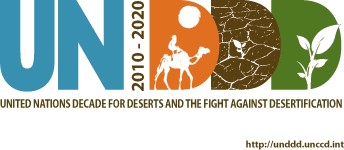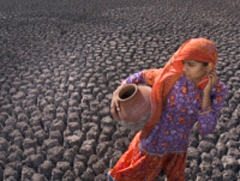Navigation
United Nations (UN) Launches Decade-Long Efforts to Tackle Desertification
The United Nations is launching the Decade for Deserts and the Fight against Desertification (2010-2020) today, 16 August 2010 , a 10-year long effort to raise awareness and action to improve the protection and management of the world's drylands.
|
The United Nations is launching the Decade for Deserts and the Fight against Desertification (2010-2020) today, 16 August 2010 , a 10-year long effort to raise awareness and action to improve the protection and management of the world's drylands, home to a third of the world's population and which face serious economic and environmental threats.
"Continued land degradation -- whether from climate change, unsustainable agriculture or poor management of water resources -- is a threat to food security, leading to starvation among the most acutely affected communities and robbing the world of productive land", said UN Secretary-General Ban Ki-moon in a statement announcing the launch.
** Video: "Desertification is a Silent Killer," a video provided by United Nations Decade for Deserts and the Fight Against Desertification (UNDDD) is at the bottom of this article.
 |
"As we begin the Decade on Deserts and the Fight against Desertification, let us pledge to intensify our efforts to nurture the land we need for achieving the Millennium Development Goals and guaranteeing human well-being", he added.
On a global scale, desertification -- land degradation in drylands -- affects 3.6 billion hectares, which accounts for 25 percent of the Earth's terrestrial land mass. It threatens the livelihoods of more than 1 billion people in some 100 countries.
Against this backdrop, UN Member States addressed growing desertification and land degradation by adopting a resolution to dedicate the next decade to combating desertification and improving the protection and management of the world's drylands in 2007.
The global launch took place in Fortaleza, Brazil, in the State of Ceara, Brazil's semi-arid region, during the Second International Conference: Climate, Sustainability and Development in Semi-arid Regions.
While concerns about desertification are growing, it is not all doom and gloom. Efforts have been made to address land degradation and while there have been positive outcomes, more action is needed to arrest and reverse land degradation and creeping desertification worldwide.
The Decade is designed to heighten public awareness about the threat desertification, land degradation and drought pose to sustainable development and ways leading to their alleviation.
Value of Deserts and Drylands
* 2.1 billion people, about 40% of the world's population, live in the
world's deserts and drylands
* 90% of this population is in developing countries
* 50% of the world's livestock is supported by rangelands
* 46% of global carbon is stored in drylands
* 44% of all cultivated land is in drylands
* 30% of all cultivated plants come from drylands
* 8 of the 25 global hotspots are in the drylands; these are areas where
0.5% of the plant species are endemic to the region but habitat loss
exceeds 70%
Desertification Threats
* Desertification affects 3.6 billion hectares of land worldwide - or 25% of the Earth's terrestrial land mass
* 110 countries at risk of land degradation
* 12 million hectares of land, an area the size of Benin, are lost every year
* Annual land lost could produce 20 million tons of grain
* $42 billion in income is lost every year from desertification and land degradation
Luc Gnacadja, Executive Secretary of the UN Convention to Combat Desertification, warned that the international community is at a crossroads, and must decide between a business-as-usual approach that will be characterized by severe and prolonged droughts, flooding and water shortages or an alternative path, that "channels our collective action towards sustainability."
He added that the Decade's message stresses that land is life, "so, we must ensure the drylands, remain productive and working" and that the vision for the Decade is to "forge a global partnership to reverse and prevent desertification and land degradation and to mitigate the effects of drought in affected areas in order to support poverty reduction and environmental sustainability".
In 2007, the United Nations General Assembly declared 2010-2020 the UN Decade for Deserts and the Fight against Desertification and in December 2009, it mandated five UN agencies to spearhead activities related to the Decade. These are UNEP, UNDP, the International Fund for Agricultural Development (IFAD), the UN Department of Public Information (DPI) and the Secretariat for the UN Convention to Combat Desertification.
United Nations Convention to Combat Desertification (UNCCD)
Established in 1994, the United Nations Convention to Combat Desertification (UNCCD) is the sole legally binding international agreement linking environment, development and the promotion of healthy soils. The Convention's 193 signatory countries, or Parties, work to alleviate poverty in the drylands, maintain and restore the land's productivity and mitigate the effects of drought. The Convention expects Iraq to be its 194th member next week with Iraq's accession on 28 August 2010.
Also today, the regional launch for Africa was held in Nairobi, Kenya, at the headquarters of the United Nations Environment Programme (UNEP) and in partnership with the United Nations Development Programme (UNDP). Other regional launches are scheduled to take place in New York, in September, for the North American region, in the Republic of Korea in October, for the Asian region, and in November for the European region.
This news is from UNEP, 16 August 2010.
Note:
Forthcoming Publication:
“Water and Sanitation Related Diseases and the Environment: Challenges, Interventions and Preventive Measures,”
a John Wiley & Sons, Inc. - Horizon International Publication, will soon be available.
The print copy of the book will be accompanied by a multimedia DVD.
Special Web sites established by John Wiley & Sons, Inc. and by the Horizon Solutions Site at www.solutions-site.org will present the electronic version of the book, the DVD and other Supplementary Material.
Written by authorities from the fields of public health, medicine, epidemiology, environmental health, climate change, environmental engineering, and population research, this book presents an interdisciplinary picture of the conditions responsible for water and sanitation-related diseases, the pathogens and their biology, morbidity and mortality resulting from lack of safe water and sanitation, distribution of these diseases and the conditions that must be met to reduce or eradicate them.
The publication covers access to and maintenance of clean water, and guidelines for the safe use of wastewater, excreta and greywater and examples of solutions, but with an emphasis on what is achievable considering that 2.6 billion individuals have no toilet and 1.2 billion people are exposed to water-related illness from their drinking water.
Meeting water and sanitation needs coupled with protection of the environment and prevention of pollutants is essential to every effort to improve the health and living conditions of billions of people. Meeting these needs is fundamental not only to effectively diminish incidence of diseases that afflict a third or more of the people of the world, but also to improve education and economic well-being and elevate billions of individuals out of vicious cycles of poverty.
Preventive measures and solutions provide guidance for possible action on the local, national and international levels.
Watch for announcements of the publication date and availability.
"Desertification is a Silent Killer," a video provided by United Nations Decade for Deserts and the Fight Against Desertification (UNDDD). http://www.unddd.unccd.int.
Search
Latest articles
Agriculture
- World Water Week: Healthy ecosystems essential to human health: from coronavirus to malnutrition Online session Wednesday 24 August 17:00-18:20
- World Water Week: Healthy ecosystems essential to human health: from coronavirus to malnutrition Online session Wednesday 24 August 17:00-18:20
Air Pollution
- "Water and Sanitation-Related Diseases and the Changing Environment: Challenges, Interventions, and Preventive Measures" Volume 2 Is Now Available
- Global Innovation Exchange Co-Created by Horizon International, USAID, Bill and Melinda Gates Foundation and Others
Biodiversity
- It is time for international mobilization against climate change
- World Water Week: Healthy ecosystems essential to human health: from coronavirus to malnutrition Online session Wednesday 24 August 17:00-18:20
Desertification
- World Water Week: Healthy ecosystems essential to human health: from coronavirus to malnutrition Online session Wednesday 24 August 17:00-18:20
- UN Food Systems Summit Receives Over 1,200 Ideas to Help Meet Sustainable Development Goals
Endangered Species
- Mangrove Action Project Collaborates to Restore and Preserve Mangrove Ecosystems
- Coral Research in Palau offers a “Glimmer of Hope”
Energy
- Global Innovation Exchange Co-Created by Horizon International, USAID, Bill and Melinda Gates Foundation and Others
- Wildlife Preservation in Southeast Nova Scotia
Exhibits
- Global Innovation Exchange Co-Created by Horizon International, USAID, Bill and Melinda Gates Foundation and Others
- Coral Reefs
Forests
- NASA Satellites Reveal Major Shifts in Global Freshwater Updated June 2020
- Global Innovation Exchange Co-Created by Horizon International, USAID, Bill and Melinda Gates Foundation and Others
Global Climate Change
- It is time for international mobilization against climate change
- It is time for international mobilization against climate change
Global Health
- World Water Week: Healthy ecosystems essential to human health: from coronavirus to malnutrition Online session Wednesday 24 August 17:00-18:20
- More than 400 schoolgirls, family and teachers rescued from Afghanistan by small coalition
Industry
- "Water and Sanitation-Related Diseases and the Changing Environment: Challenges, Interventions, and Preventive Measures" Volume 2 Is Now Available
- Global Innovation Exchange Co-Created by Horizon International, USAID, Bill and Melinda Gates Foundation and Others
Natural Disaster Relief
- STOP ATTACKS ON HEALTH CARE IN UKRAINE
- Global Innovation Exchange Co-Created by Horizon International, USAID, Bill and Melinda Gates Foundation and Others
News and Special Reports
- World Water Week: Healthy ecosystems essential to human health: from coronavirus to malnutrition Online session Wednesday 24 August 17:00-18:20
- STOP ATTACKS ON HEALTH CARE IN UKRAINE
Oceans, Coral Reefs
- World Water Week: Healthy ecosystems essential to human health: from coronavirus to malnutrition Online session Wednesday 24 August 17:00-18:20
- Mangrove Action Project Collaborates to Restore and Preserve Mangrove Ecosystems
Pollution
- Zakaria Ouedraogo of Burkina Faso Produces Film “Nzoue Fiyen: Water Not Drinkable”
- "Water and Sanitation-Related Diseases and the Changing Environment: Challenges, Interventions, and Preventive Measures" Volume 2 Is Now Available
Population
- "Water and Sanitation-Related Diseases and the Changing Environment: Challenges, Interventions, and Preventive Measures" Volume 2 Is Now Available
- "Water and Sanitation-Related Diseases and the Changing Environment: Challenges, Interventions, and Preventive Measures" Volume 2 Is Now Available
Public Health
- Honouring the visionary behind India’s sanitation revolution
- Honouring the visionary behind India’s sanitation revolution
Rivers
- World Water Week: Healthy ecosystems essential to human health: from coronavirus to malnutrition Online session Wednesday 24 August 17:00-18:20
- Mangrove Action Project Collaborates to Restore and Preserve Mangrove Ecosystems
Sanitation
- Honouring the visionary behind India’s sanitation revolution
- Honouring the visionary behind India’s sanitation revolution
Toxic Chemicals
- "Water and Sanitation-Related Diseases and the Changing Environment: Challenges, Interventions, and Preventive Measures" Volume 2 Is Now Available
- Actions to Prevent Polluted Drinking Water in the United States
Transportation
- "Water and Sanitation-Related Diseases and the Changing Environment: Challenges, Interventions, and Preventive Measures" Volume 2 Is Now Available
- Urbanization Provides Opportunities for Transition to a Green Economy, Says New Report
Waste Management
- Honouring the visionary behind India’s sanitation revolution
- Honouring the visionary behind India’s sanitation revolution
Water
- Honouring the visionary behind India’s sanitation revolution
- Honouring the visionary behind India’s sanitation revolution
Water and Sanitation
- Honouring the visionary behind India’s sanitation revolution
- Honouring the visionary behind India’s sanitation revolution


